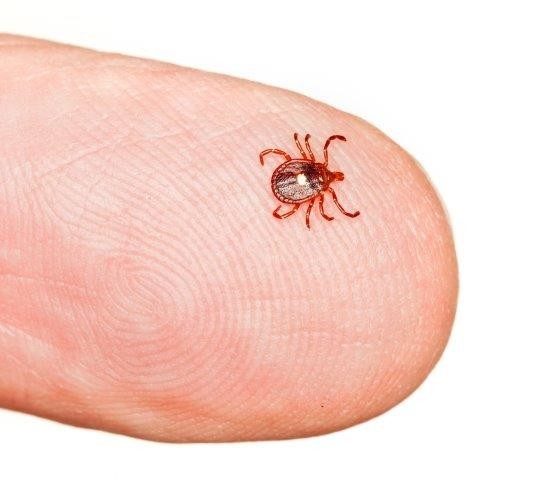FOR IMMEDIATE RELEASE | August 27, 2019
New way to bump off ticks: Dry up their saliva (video)
Note to journalists: Please report that this research will be presented at a meeting of the American Chemical Society.
A press conference on this topic will be held Monday, Aug. 26, at 11 a.m. Pacific time in the San Diego Convention Center. Reporters may check in at the press center, Room 14A, Mezzanine Level, or watch live on YouTube at http://bit.ly/acs2019sandiego. To ask questions online, sign in with a Google account.
SAN DIEGO, Aug. 26, 2019 — Saliva from a tick’s bite can transmit pathogens that cause serious illnesses, such as Lyme disease, and significant agricultural losses. Current insecticides have drawbacks, so scientists have been seeking new ways to prevent these pesky arachnids from spreading pathogens. Now, researchers report that compounds they previously identified can dry up ticks’ saliva by upsetting the balance of ions in the salivary gland, reducing feeding and potentially limiting pathogen transmission.
The researchers will present their results today at the American Chemical Society (ACS) Fall 2019 National Meeting & Exposition. ACS, the world’s largest scientific society, is holding the meeting here through Thursday. It features more than 9,500 presentations on a wide range of science topics.
A brand-new video on the research is available at www.acs.org/HLS_Dry_Ticks.
“Lyme disease is exploding in the northeastern U.S.,” says Daniel Swale, Ph.D., the project’s principal investigator. “Most methods to kill ticks in the agricultural sector involve the use of neurotoxic insecticides, but it’s difficult to effectively use these insecticides to control ticks in residential areas. So we wanted to identify a new way to control these disease-carrying ticks.”
“We knew that the salivary gland is critical to the biological success of ticks, suggesting it had potential as a target for a pesticide that works through a new mechanism,” Zhilin Li, a doctoral student who is presenting the work at the meeting, says. The researchers, who are at Louisiana State University, reasoned that if they could stop ticks from producing saliva, then they could prevent them from feeding — a situation that would be incompatible with sustaining life.
Li and Swale focused on a potassium ion channel, known as a Kir channel, which has been shown to be important for the excretory systems of arthropods –– a classification of animals that includes mosquitoes, as well as ticks. These microscopic channels allow potassium to move in and out of cells in the salivary gland and elsewhere in the ticks, maintaining an ionic balance essential to saliva secretion and the ticks’ health.
In their current work, they fed ticks blood laced with two compounds known to act on the Kir channels. Two of the molecules — known as VU0071063 and pinacidil, a human hypertension drug — were effective, reducing saliva secretion by 95% or more and reducing blood ingestion by approximately 15-fold. Importantly, ticks that fed on bovine blood infused with either of these compounds were dead within 12 hours. That timeframe is significant because transmission of pathogens via ticks’ saliva into their human or animal hosts typically takes at least 12 hours and sometimes as many as 40 hours. These initial studies were conducted in artificial host feeding systems that contained a blood meal. Next, the researchers plan to test whether their treatment can in fact prevent pathogen transmission when ticks feed on rodents.
Ticks removed from the blood meal before they died were obviously sick, the researchers report. The ticks were uncoordinated and lethargic, and they couldn’t walk well. The researchers attribute this behavior to an imbalance of potassium, sodium and chloride ions in the ticks. Normally, when a tick feeds, its saliva returns excess water and ions from human or animal blood back into the host. But the treated ticks were spitting out more ions despite producing much less saliva, disrupting their biological functions. “We think their nervous system wasn't working normally, and we suspect that’s why we saw high mortality in the treated ticks,” Li says.
Li and Swale will follow up on initial results suggesting that the ion channel is expressed in the salivary gland only during blood feeding and then disappears. And the researchers are zeroing in on the exact type of cells in which the ion channels are produced within the salivary gland. Once they have a more complete understanding of the reliance of blood feeding and pathogen transmission on Kir channel function, they hope industry can use their findings to create a commercial product such as a spray for gardens, or an injection or oral treatment for the agricultural industry for those animals at risk of getting tick bites. Swale notes that the method also seems to reduce saliva production and feeding in aphids and fruit flies, so it could potentially be used to control these agricultural pests, too.
The researchers acknowledge support and funding from the U.S. Department of Agriculture Agricultural Research Service.
The American Chemical Society, the world’s largest scientific society, is a not-for-profit organization chartered by the U.S. Congress. ACS is a global leader in providing access to chemistry-related information and research through its multiple databases, peer-reviewed journals and scientific conferences. ACS does not conduct research, but publishes and publicizes peer-reviewed scientific studies. Its main offices are in Washington, D.C., and Columbus, Ohio.
Media Contact
ACS Newsroom
newsroom@acs.org






